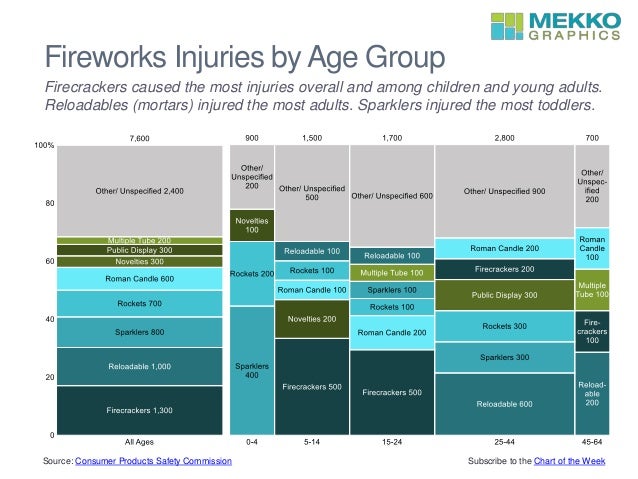Winston
Lorenzo von Matterhorn
- Joined
- Jan 31, 2009
- Messages
- 9,560
- Reaction score
- 1,749
Consumption:
https://www.americanpyro.com/assets/docs/FactsandFigures/Fireworks Consump. Figures 2000-17.pdf
Sources:

Revenue:

US emergency department visits for fireworks injuries, 2006–2010
https://www.journalofsurgicalresearch.com/article/S0022-4804(14)00346-1/fulltext
There were 25,691 emergency department visits for fireworks-related injuries between 2006 and 2010. There was no consistent trend in annual injury rates during the 5-y period. The majority of visits (50.1%) were in patients aged <20 y. Most injuries were among males (76.4%) and were treated in hospitals in the Midwest and South (42.0% and 36.4%, respectively) than in the West and Northeast (13.3% and 8.3%, respectively) census regions. Fireworks-related injuries were most common in July (68.1%), followed by June (8.3%), January (6.6%), December (3.4%), and August (3.1%). The most common injuries (26.7%) were burns of the wrist, hand, and finger, followed by contusion or superficial injuries to the eye (10.3%), open wounds of the wrist, hand, and finger (6.5%), and burns of the eye (4.6%).


These are the people going to hospitals for fireworks injuries
July 3, 2019
https://www.cnn.com/2019/07/03/us/fireworks-injuries-fourth-of-july-trnd/index.html
More than 9,000 people were treated for fireworks-related injuries last year, according to the US Consumer Product Safety Commission. Nearly 62 percent of those injuries happened during a one-month study period between June 22, 2018 and July 22, 2018.
So it's worth reminding your friends and family not to take extra care when preparing for their celebrations.
Here are some stats from the commission to keep in mind:
Firecrackers were involved in most of injuries
About 1,000 injuries were from firecrackers, 500 from sparklers 400 from Roman candles and 200 from bottle rockets.
Mostly men were the ones getting injured
Of the number of reported injuries in 2018, 64 percent were to men, while 36 percent were to women.
Young people were commonly treated
Nearly half of the estimated treated fireworks-related injuries were to people younger than 20 years old. Kids under the age of 15 made up 36 percent of the estimated injuries.
Body parts most injured were hands and fingers
Hands and fingers in 2018 were an estimated 28 percent of injuries treated, while arms were about 4 percent. Legs were 24 percent, eyes 19 percent and head, face and ear injuries made up 15 percent.
https://www.americanpyro.com/assets/docs/FactsandFigures/Fireworks Consump. Figures 2000-17.pdf
Sources:

Revenue:

US emergency department visits for fireworks injuries, 2006–2010
https://www.journalofsurgicalresearch.com/article/S0022-4804(14)00346-1/fulltext
There were 25,691 emergency department visits for fireworks-related injuries between 2006 and 2010. There was no consistent trend in annual injury rates during the 5-y period. The majority of visits (50.1%) were in patients aged <20 y. Most injuries were among males (76.4%) and were treated in hospitals in the Midwest and South (42.0% and 36.4%, respectively) than in the West and Northeast (13.3% and 8.3%, respectively) census regions. Fireworks-related injuries were most common in July (68.1%), followed by June (8.3%), January (6.6%), December (3.4%), and August (3.1%). The most common injuries (26.7%) were burns of the wrist, hand, and finger, followed by contusion or superficial injuries to the eye (10.3%), open wounds of the wrist, hand, and finger (6.5%), and burns of the eye (4.6%).


These are the people going to hospitals for fireworks injuries
July 3, 2019
https://www.cnn.com/2019/07/03/us/fireworks-injuries-fourth-of-july-trnd/index.html
More than 9,000 people were treated for fireworks-related injuries last year, according to the US Consumer Product Safety Commission. Nearly 62 percent of those injuries happened during a one-month study period between June 22, 2018 and July 22, 2018.
So it's worth reminding your friends and family not to take extra care when preparing for their celebrations.
Here are some stats from the commission to keep in mind:
Firecrackers were involved in most of injuries
About 1,000 injuries were from firecrackers, 500 from sparklers 400 from Roman candles and 200 from bottle rockets.
Mostly men were the ones getting injured
Of the number of reported injuries in 2018, 64 percent were to men, while 36 percent were to women.
Young people were commonly treated
Nearly half of the estimated treated fireworks-related injuries were to people younger than 20 years old. Kids under the age of 15 made up 36 percent of the estimated injuries.
Body parts most injured were hands and fingers
Hands and fingers in 2018 were an estimated 28 percent of injuries treated, while arms were about 4 percent. Legs were 24 percent, eyes 19 percent and head, face and ear injuries made up 15 percent.




